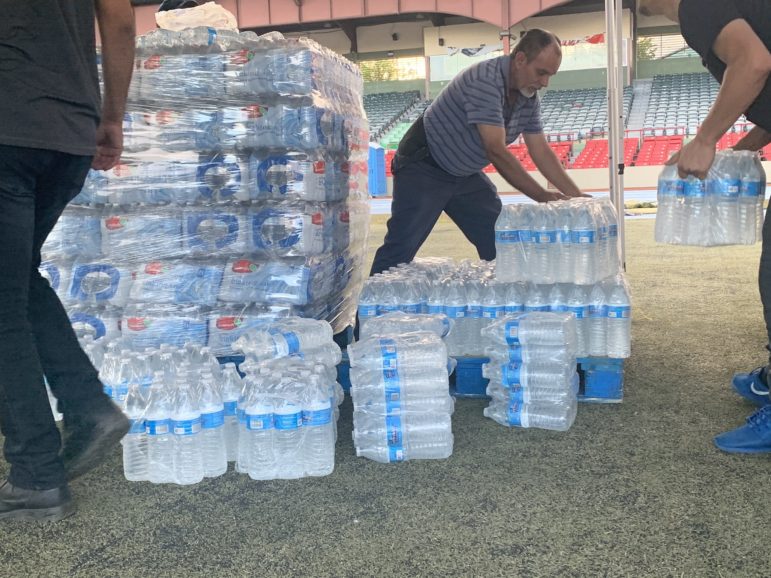
NMEADS
Emergency water supplies get unloaded in Puerto Rico shortly after the first of the recent earthquakes.The morning of January 7 was sadly all too familiar for countless New Yorkers, including myself. The moment we woke up to hear of a 6.4 earthquake striking Puerto Rico, New Yorkers in the Diaspora spent excruciating hours trying and failing to contact family members still on the island, like my grandparents. When I finally heard that they survived, clutching each other together in a corner of their home, that sinking feeling was certainly replaced with relief, but also an anxiousness that I have felt ever since Hurricane Maria.
While New York recognizes that the Puerto Rican diaspora is central to the story of New York, our long-term commitment to this group and others who are being displaced by disasters and climate change is part of a new unknown that we have to reckon with. Let me be clear – Mayor de Blasio did listen to the requests from me and my fellow Council Members to send senior city experts and personnel to Puerto Rico to assist in disaster coordination after this week’s earthquakes. And Governor Cuomo rapidly deployed personnel from the New York Power Authority to Puerto Rico to assist in restoring power.
But as the trauma from these earthquakes continues, our attention in New York is once again turning to the future of our island residents and those who may consider leaving. FEMA has reported that shelters have been set up across the island, although numerous residents are living outdoors due to fears of further shaking. Schools remain closed across Puerto Rico while the government assesses structural safety. It’s not surprising some would consider leaving, even for a short period of time, and New York is a likely destination.
It’s estimated that 130,000 Puerto Ricans fled the island after Hurricane Maria – about 4% of the island’s population at the time. Most fled to New York and Florida, longtime bastions for boricuas. And some estimates put the number of potential climate refugees worldwide at as high as one billion by 2050.
That is why, with thoughts of Maria in mind and future disasters that may come, I introduced legislation last year to establish a Climate Migrant Services Coordinator in the Mayor’s Office. This person would be responsible for coordinating a multi-agency response for individuals who have been displaced by severe weather or natural disaster events.
We need to ensure that evacuees arrive with clear direction on where to go to receive supplies, connections to services, and healthcare and education screenings. Our city’s housing plan for new arrivals can’t just be federal help, family friends, or a homeless shelter. And most importantly, New York’s response to these climate refugees can’t simply disappear when the headlines do.
We don’t know how many people will depart the island because of this earthquake, but the city must ensure its plans for handling any Puerto Ricans evacuees are up-to-date and reflective of lessons learned from the months after Maria.
In 2017, the Julio de Burgos Center in East Harlem was established to attempt to achieve a central operation. But the offerings provided were really only meant for one-time visits, and the operation folded with hundreds of Puerto Ricans still looking for help. We simply didn’t make the long-last connections with displaced people that could lead to showing them the available resources that could help them rebuild their lives.
 CityViews are readers’ opinions, not those of City Limits. Add your voice today!
CityViews are readers’ opinions, not those of City Limits. Add your voice today!
Instead, we relied too heavily on a federal solution to this crisis. But that was never going to come. Of the more than 1.1 million Puerto Ricans who registered for FEMA help after Hurricane Maria, 2 out of 5 applicants were deemed ineligible for various types of assistance, the Washington Post reported, often because they had lost documents proving they were victims of disaster. And funding for temporary housing in New York and elsewhere was ended in September 2018, less than a year after Maria struck. Even today, with thousands still struggling to recover from Maria, the Trump administration has still not provided billions in disaster aid that was allocated by Congress in the wake of Maria.
Whether we like it or not, climate refugees will always consider New York a safe haven – and they should. It’s part of what makes New York special. But if we don’t want to further strain our limited safety net resources, we have to develop a permanent settlement program that gets refugees involved in our communities, with permanent housing, job and language training, and a sense of purpose for these new New Yorkers.
I hope that in our fight for Puerto Rico’s future, we are also thinking about the future New York must play in all climate disasters.
Councilmember Carlina Rivera (D) represents the 2nd Council District which includes the diverse neighborhoods of the East Village, Flatiron, Gramercy Park, Rose Hill, Kips Bay, Murray Hill, and the Lower East Side.








